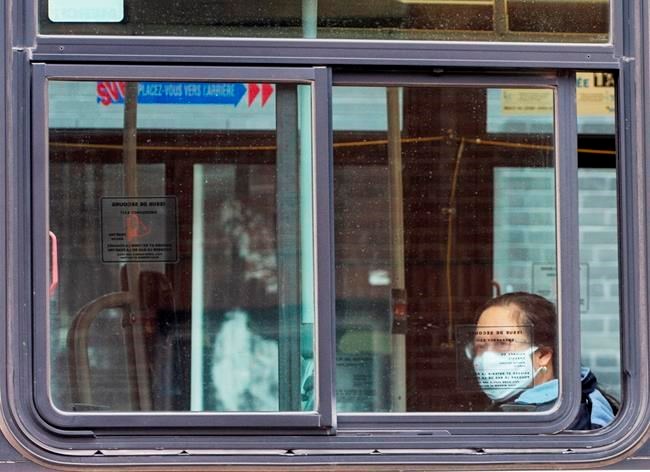TORONTO — No one knows when a fresh surge of COVID-19 cases will emerge in Canada, but experts agree numbers are poised to rise and could very well explode in surveillance blindspots.
One need only look to South Korea, where infections spread anew through Seoul's nightclubs and bars, to see how quickly containment successes unravel when undetected cases spark flareups.
Of course, nightclubs remain closed in Canada, but the infection risk of a vast array of public spaces is being tested for the first time in coming weeks — retail stores, golf ranges, bar patios and some offices among them.
A "tried and true" principle with any respiratory virus is that infection risk is lower outside and in larger spaces where germs can dissipate, says Dr. Camille Lemieux, medical lead for the COVID-19 assessment centre at Toronto's Western Hospital.
That's opposed to small, confined areas with poor ventilation, but the speed of this novel coronavirus to find human hosts is what's most concerning, says Lemieux.
"The one thing about COVID that I think has a lot of people stymied is the rapidity with which it spreads when it gets a foothold," says Lemieux, also chief of family medicine at the University Health Network in Toronto.
Even with containment, the virus is circulating in the community thanks to a small percentage of people with mild and no symptoms who don't even know they are sick, adds Dr. Gerald Evans, medical director of infection control at the Kingston Health Sciences Centre.
Evans says "second waves are inevitable" as regions open up, using the term loosely to mean any uptick big or small. He cautions against suggesting one sector of public life — such as the tennis court — is safer from the virus than others.
"If people start congregating around campfires and other things in parks, and then large groups of golfers are getting together and hanging out, that could facilitate transmission," says Evans, also chair of the division of infectious diseases at Queen's University.
If Evans were to guess, he says a Canadian resurgence is very likely to start among younger adults who resume social activities, suggesting they're more likely to risk exposure and will have been largely shielded from infection.
"They have been in literal isolation now for months," Evans notes.
"So, when we start to open restaurants, and we start to open social venues, I think what we saw in Korea is a distinct possibility of what might emerge here."
This may sound obvious but wherever it happens, it'll be precisely where we are not looking, says Lemieux, which is why ramped-up testing and contact tracing measures are critical as millions of Canadians consider increased exposure.
She stressed the need for aggressive surveillance that can quickly respond to any signs of resurgence.
"The only way we can do that is by allowing broad-based testing of the public," says Lemieux, a vocal critic of testing rates in Ontario.
"We really need to be on a seek-and-destroy kind of strategy right now where we're actually actively going and looking for pockets of transmission of the virus."
As with case numbers, relaxed measures vary from province to province — licensed daycares can reopen Tuesday in New Brunswick, some classroom activity has already resumed in Quebec, while hair salons and restaurant patios recently opened in Manitoba.
Evans suggests Ontario should have waited another "two to four weeks" before allowing a slew of reopenings set for Tuesday, which include construction sites, dog grooming, and some brick-and-mortar stores.
It's clear though, that political and medical leaders are wary of possible setbacks: Premier Doug Ford urged businesses to only open if they were absolutely ready and asked residents to continue limiting their outings, while on Friday the Ontario Medical Association encouraged those who venture out to wear a mask.
Patrick Saunders-Hastings, an epidemiologist and consultant with the management consulting firm Gevity Consulting Inc., says a phased approach should allow public health to recognize and respond to warning signs before an exponential increase occurs.
And because the infection rate is on the decline, provinces should be able to stamp out threats posed by every new case.
"We are better able to conduct that sort of 'test, trace and isolate' framework than we were earlier on in this outbreak," Saunders-Hastings suggests.
When it comes to labour risk, larger businesses have greater capacity than small ones to enforce public health guidelines and even augment them with their own contact tracing and staff education efforts, he says.
"We see a great degree of diversity in the types of strategies that are being looked at — whether it's screening for fevers, whether it's the use of phone applications to conduct contact tracing on site and adherence to social-distancing," says Saunders-Hastings, adding that ongoing physical distancing rules mean most offices will only be able to bring back 20 to 40 per cent of employees.
While industrial settings such as meat plants have already suffered COVID-19 outbreaks, he cautions against assuming where the next workplace outbreak could occur, noting adherence to safety guidelines can falter anywhere.
Existing prevalence of COVID-19 infections offer little guidance, too, says Evans, noting it's tempting to assume infection risk is lower in his city of Kingston, Ont., than Toronto.
He fears what might happen if big-city dwellers hit the road for a day trip, bringing the virus to a region highly susceptible precisely because counts are low.
"If the virus were to be reintroduced either from, say, Toronto or Montreal where there's more activity, then there is a larger population that could get it so a second wave would look potentially worse here."
This report by The Canadian Press was first published May 16, 2020.
Cassandra Szklarski, The Canadian Press




